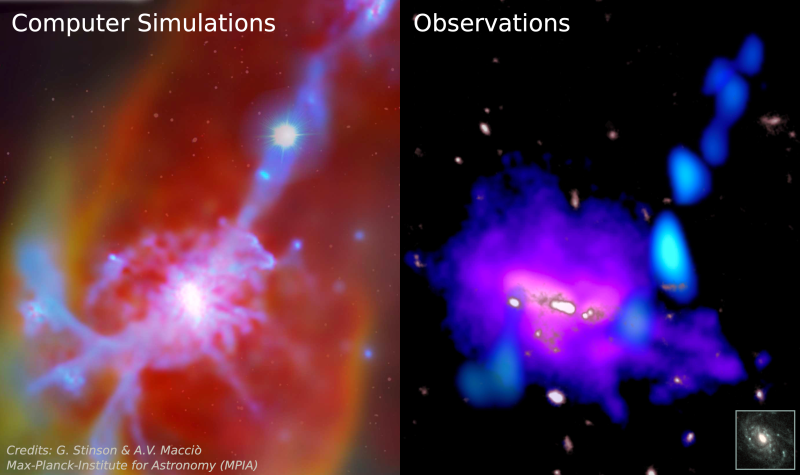Publication of the CRAL in the journal Science on March 30, 2023. Communication of the CNRS-INSU on April 14, 2023.
In this study, published in the journal Science, an international team involving French scientists from the Lyon Astrophysics Research Center (CRAL - OSUL, CNRS / ENS de Lyon / Claude Bernard Lyon 1 University) and the Institut d'astrophysique de Paris (IAP, CNRS/Sorbonne University) focus on one of the processes involved in the formation and evolution of galaxies.
An intergalactic gas stream at cosmic noon
Galaxies grow by accreting material, either in mergers with other galaxies or from gas in the intergalactic medium. Emonts et al. used submillimeter observations to map the atomic carbon gas around a massive galaxy at redshift 3.8, early in a period known as cosmic noon, when galaxies were rapidly assembling (see the Perspective by Casey). They identified a stream of cold gas several times the size of the galaxy extending away from it into the intergalactic medium. The mass of gas in the stream would be sufficient to maintain star formation in the galaxy for hundreds of millions of years if it is accreted. —KTS
Abstract
The growth of galaxies in the early Universe is driven by accretion of circum- and intergalactic gas. Simulations have predicted that steady streams of cold gas penetrate the dark matter halos of galaxies and provide the raw material necessary to sustain star formation. We report a filamentary stream of gas that extends for 100 kiloparsecs and connects to the massive radio galaxy 4C 41.17. We detected the stream using submillimeter observations of the 3P1 to 3P0 emission from the [C i] line of atomic carbon, a tracer of neutral atomic or molecular hydrogen gas. The galaxy contains a central gas reservoir that is fueling a vigorous starburst. Our results show that the raw material for star formation can be present in cosmic streams outside galaxies.

Left: computer simulations of a cosmic stream (Crighton et al. 2013, ApJL, 776, L18; Max-Planck-Institute for Astronomy press release). Right: observation of a cosmic stream flowing overa galaxy. The cosmic filament of cold gas is detected by the ALMA radio telescope and highlighted in blue, spreading from the upper right corner of the image towards the galaxy in the center. The purple colors represent a large pool of gas accumulated around the galaxy, while individual galaxies are shown in gray. The total length of the filament is nearly half a million light-years. For comparison, the rendering of a galaxy the size of our Milky Way is shown at the same scale in the lower right corner.
Credits - Left: G. Stinson & A.V. Maccio / MPIA - Right: B. Emonts / NRAO / AUI / NSF
Reference: A cosmic stream of atomic carbon gas connected to a massive radio galaxy at redshift 3.8. Bjorn H. C. Emonts, Matthew D. Lehnert, Ilsang Yoon , Nir Mandelker, Montserrat Villar-Martín , George K. Miley , Carlos De Breuck , Miguel A. Pérez-Torres , Nina A. Hatch , Pierre Guillard. Science, March 30, 2023.
DOI: 10.1126/science.abh2150






